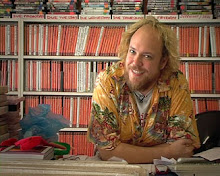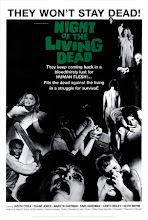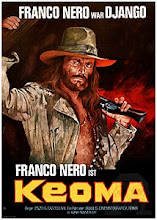 Dementia 13
Dementia 13 aka The Haunted And The Hunted
Director/Writer Francis Ford Coppola Producer Roger Corman Second Unit Director Jack Hill
Cast William Campbell (Richard Haloran), Luana Anders (Louise Haloran), Bart Patton (Billy Haloran), Mary Mitchel (Kane), Patrick Magee (Justin Caleb)
 Tonight we’re screening two VERY early films by the future director of The Godfather trilogy and Apocalypse Now, Francis Ford Coppola. Young Francis was still doing graduate film work at UCLA when he was poached by the talent-conscious Roger Corman, and proceeded to work in Corman’s film factory in every possible capacity, including the patchwork science fiction Battle Beyond The Sun. He also directed two undistinguished adults-only features without Corman’s involvement: the nudie semi-western Tonight For Sure (1962) with Jack Hill as assistant, and The Bellboy and the Playgirls (also 1962), a 3D sex comedy partly edited from a German feature. At this point in Corman’s career his shoestring finesse was taking him as far as
Tonight we’re screening two VERY early films by the future director of The Godfather trilogy and Apocalypse Now, Francis Ford Coppola. Young Francis was still doing graduate film work at UCLA when he was poached by the talent-conscious Roger Corman, and proceeded to work in Corman’s film factory in every possible capacity, including the patchwork science fiction Battle Beyond The Sun. He also directed two undistinguished adults-only features without Corman’s involvement: the nudie semi-western Tonight For Sure (1962) with Jack Hill as assistant, and The Bellboy and the Playgirls (also 1962), a 3D sex comedy partly edited from a German feature. At this point in Corman’s career his shoestring finesse was taking him as far as
 Corman’s response to Hitchcock's Psycho (1960) was to give Francis Ford Coppola most of his cast of The Young Racers (who Coppola was assisting on) and his own feature to shoot in
Corman’s response to Hitchcock's Psycho (1960) was to give Francis Ford Coppola most of his cast of The Young Racers (who Coppola was assisting on) and his own feature to shoot in
 It has all the hallmarks of the gothic genre – castles, guilt, madness, death – but with a more modish psychological flavour. Water, and specifically the pond Kathleen drowned in, is the omnipresent source of menace and doom, and the scene of a particularly gruelling axe murder filmed partly below the waterline. It’s not just the film’s frequent shocks, padded out with gory second unit material from Jack Hill, that keep the interest - imaginative cinematography and sound bring the film almost out of its B-film status, as does the added class of intense British actor Patrick Magee (best remembered from his vein-popping role in A Clockwork Orange) playing the curious family doctor.
It has all the hallmarks of the gothic genre – castles, guilt, madness, death – but with a more modish psychological flavour. Water, and specifically the pond Kathleen drowned in, is the omnipresent source of menace and doom, and the scene of a particularly gruelling axe murder filmed partly below the waterline. It’s not just the film’s frequent shocks, padded out with gory second unit material from Jack Hill, that keep the interest - imaginative cinematography and sound bring the film almost out of its B-film status, as does the added class of intense British actor Patrick Magee (best remembered from his vein-popping role in A Clockwork Orange) playing the curious family doctor.
 If the denouement doesn’t seem that shocking or surprising, just remember we’ve seen 45 years worth of slashers since. It’s true Coppola at times isn’t entirely sure if he’s trying to be Hitchcock or Herschell Gordon Lewis and things like focus and logic tend to evaporate on the set of a Corman quickie, but like the wave of similarly-themed giallo shockers from Europe, its illogic actually works in its favour to whip up a kind of delirium in its audience. Much closer in tone to the Italian thrillers of Mario Bava than any of its Stateside competition, it’s years ahead of its time, filled with moments of quiet, perverse genius. Coppola himself tends to disown his first two nudies and cites this as his first real feature, and if I was Coppola I’d be proud of it too: the minor horror masterpiece Dementia 13.
If the denouement doesn’t seem that shocking or surprising, just remember we’ve seen 45 years worth of slashers since. It’s true Coppola at times isn’t entirely sure if he’s trying to be Hitchcock or Herschell Gordon Lewis and things like focus and logic tend to evaporate on the set of a Corman quickie, but like the wave of similarly-themed giallo shockers from Europe, its illogic actually works in its favour to whip up a kind of delirium in its audience. Much closer in tone to the Italian thrillers of Mario Bava than any of its Stateside competition, it’s years ahead of its time, filled with moments of quiet, perverse genius. Coppola himself tends to disown his first two nudies and cites this as his first real feature, and if I was Coppola I’d be proud of it too: the minor horror masterpiece Dementia 13.
aka Nebo Zovët/“The Heavens Call”
Directors “Thomas Colchart”/Francis Ford Coppola, [uncredited] Aleksandr Kozyr, Mikhail Karyukov Writers “Thomas Colchart”/Francis Ford Coppola, [uncredited] Mikhail Karzhukov, Yevgeni Pomeshchikov, Aleksey Sazanov
Cast Ivan Pereverzev, Aleksandr Shvorin, Konstantin Bartashevich, Larisa Borisenko, V. Chernyak, Viktor Dobrovolskiy, Taisija Litvinenko, L. Lobov, Alla Popova
 A cheap way to make an effects-heavy film in the Fifties and Sixties was to sniff around behind the Iron Curtain for a bargain, strip it, repaint and reupholster it, and call it a Chrysler. Corman purchased a Soviet science fiction film Nebo Zovyot or “The Heavens Call” (1959) for Filmgroup and handed it to his young protégé Francis Ford Coppola to dumb it down for an American audience. Coppola is only listed in the credits as Associate Producer, but that’s him as writer/director “Thomas Colchart”. The Russian cast and crew members’ names, however, have been Americanized out of existence, thus putting East-West relations back another ten years.
A cheap way to make an effects-heavy film in the Fifties and Sixties was to sniff around behind the Iron Curtain for a bargain, strip it, repaint and reupholster it, and call it a Chrysler. Corman purchased a Soviet science fiction film Nebo Zovyot or “The Heavens Call” (1959) for Filmgroup and handed it to his young protégé Francis Ford Coppola to dumb it down for an American audience. Coppola is only listed in the credits as Associate Producer, but that’s him as writer/director “Thomas Colchart”. The Russian cast and crew members’ names, however, have been Americanized out of existence, thus putting East-West relations back another ten years.
 Its paean to Soviet technology and ingenuity is also lost somewhere in its shaky translation. The original’s Russian cosmonauts race to the Red Planet (no, not that kind of Red) and are foiled by the greed and incompetence of their Amerikanski collaborators. In Coppola’s redux, the poles have switched: the villainous Amer-I-Can’ts are now sporting t-shirts that say “Amer-I-Can”. Following a global nuclear war, the Earth is now divided into the good guys in the Southern Hemis, naturally with American accents and surnames; the North Hemis launch their own ship but have cut the fuel budget and so the rocket mission is forced to land – supposedly above or beyond the sun, Coppola’s new dialogue doesn’t explain which – on a planetoid rock named Ankhor literally crawling with alien menace.
Its paean to Soviet technology and ingenuity is also lost somewhere in its shaky translation. The original’s Russian cosmonauts race to the Red Planet (no, not that kind of Red) and are foiled by the greed and incompetence of their Amerikanski collaborators. In Coppola’s redux, the poles have switched: the villainous Amer-I-Can’ts are now sporting t-shirts that say “Amer-I-Can”. Following a global nuclear war, the Earth is now divided into the good guys in the Southern Hemis, naturally with American accents and surnames; the North Hemis launch their own ship but have cut the fuel budget and so the rocket mission is forced to land – supposedly above or beyond the sun, Coppola’s new dialogue doesn’t explain which – on a planetoid rock named Ankhor literally crawling with alien menace.
 Sprinting over the end credits at a little over the hour mark, there’s the bare essentials of a science fiction adventure and little else. Characters are pared back to the bone and are barely given a chance to breathe between lines, while the word-heavy narration throws a blanket over the gaping holes in the storyline. The special effects, however, created almost ten years before 2001: A Space Odyssey (1968), are nothing short of phenomenal – no chintzy toy rockets spraying firecracker crap here. And STILL Corman wanted more creature-feature action! Undaunted, Coppola and assistant Jack Hill sprang into action and filmed inserts of a pair of intensely, deliriously Freudian space monsters (and seriously, have you ever seen an alien vagina dentata? Holy snapping seafood!).
Sprinting over the end credits at a little over the hour mark, there’s the bare essentials of a science fiction adventure and little else. Characters are pared back to the bone and are barely given a chance to breathe between lines, while the word-heavy narration throws a blanket over the gaping holes in the storyline. The special effects, however, created almost ten years before 2001: A Space Odyssey (1968), are nothing short of phenomenal – no chintzy toy rockets spraying firecracker crap here. And STILL Corman wanted more creature-feature action! Undaunted, Coppola and assistant Jack Hill sprang into action and filmed inserts of a pair of intensely, deliriously Freudian space monsters (and seriously, have you ever seen an alien vagina dentata? Holy snapping seafood!).
 In a few weeks we screen another of Corman’s patchwork efforts, Queen Of Blood (1966), one of three films stitched together from the incredible Russian film Planeta Burg. But tonight it’s Francis Ford Coppola with the shears as “Thomas Colchart” in a film tall on effects but positively dwarfish in narrative: the 1963 release Battle Beyond The Sun.
In a few weeks we screen another of Corman’s patchwork efforts, Queen Of Blood (1966), one of three films stitched together from the incredible Russian film Planeta Burg. But tonight it’s Francis Ford Coppola with the shears as “Thomas Colchart” in a film tall on effects but positively dwarfish in narrative: the 1963 release Battle Beyond The Sun.






















































































No comments:
Post a Comment